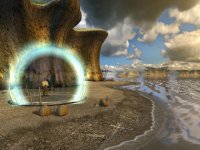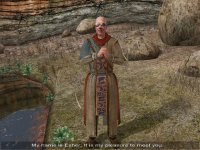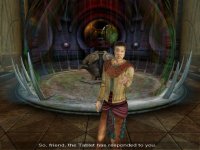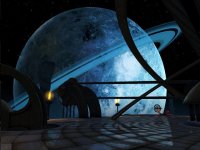|
Myst V: End of Ages — A fan's review
By Matt “Eat_My_Shortz” Giuca
So this is how it ends. The final game in the Myst series, the
greatest adventure series of all time. Is it the greatest? Does it tie
up all the loose ends and bring the series to a triumphant close? More
importantly, is it worthy of the name Myst?
First, a bit about me: I am a huge huge fan of the Myst series.
Therefore, this review is biased in favour of adventure games and Myst's
surrealistic beauty. If you are a Myst fan too, you'll probably
agree with me more than if you weren't. As much as I loved this game,
I'll be fair and I won't go easy on the criticisms!
And I did love it. Myst V is a first-class adventure game —
beautiful, intelligent, thought-provoking, and personal. It comes with
all the excitement of exploring strange, yet strangely-familiar places,
and the moments of realisation, when you've worked out a puzzle. It suffers
from a small number of design flaws, but as long as you're careful, they
shouldn't get in the way.
Graphics and Controls
 I'll
start by discussing the most contentious issue, the graphics and control
scheme. As you are no doubt aware, Myst V is presented in full
real-time 3D, and is the first game in the core Myst saga to do
so. Where previous games had you stepping through fixed nodes in a pre-rendered
world, talking to real live actors, Myst V throws all of that away,
and places you in a complete 3D environment, complete with 3D-modelled
characters. I'll
start by discussing the most contentious issue, the graphics and control
scheme. As you are no doubt aware, Myst V is presented in full
real-time 3D, and is the first game in the core Myst saga to do
so. Where previous games had you stepping through fixed nodes in a pre-rendered
world, talking to real live actors, Myst V throws all of that away,
and places you in a complete 3D environment, complete with 3D-modelled
characters.
The decision to do pre-rendered or real-time is never taken lightly in
the adventure genre these days. Whichever way you go, about half the fans
will scream and tell you you should have done it the other way. For Myst,
it doesn't help that every second game since Riven has been real-time,
and every other has been pre-rendered (if you include realMyst
and Uru). So with Myst V, a huge number of people I know
have registered their disappointment with the move to 3D, and it has been
probably the biggest complaint.
I can't say I understand them. Myst V is astounding. The graphics,
which are technically unimpressive, manage to capture the same elegance
and beauty found in all the Myst games. It's hard to tell that
they are real-time at all. Of course, they do not have the same intense
polygon-count of Myst IV, and don't have the same level of detail.
But, I'd say the worlds overall are just as beautiful.
As far as controls go, Cyan have finally hit the nail on the head. In
their previous real-time 3D attempts, realMyst and Uru,
there have been bucket-loads of complaints about the difficulty of the
game's controls. So someone at Cyan had a brain-wave: why not let users
choose their own control scheme, out of the “classic” Myst/Riven
scheme, the “classic-plus” Myst III/Myst IV
scheme, and the “free-move” realMyst scheme. Not only
does this let more advanced users (especially first-person shooter players)
move anywhere they like, and let less-capable users control the game easily,
but it also lets players switch on-the-fly to choose the best control
scheme for certain situations.
For example, I like to stick with classic-plus mode most of the time
— I find that it lets me get around quickly and see everything I
need to, from a position chosen by people who know what I need to see.
But, I switch to free-move when I need to get a close-up look at something,
or see it from a different angle, and I switch to classic mode when I
need to move along a long corridor. The modes can be switched easily by
hitting the 1, 2 and 3 keys, a handy feature which is not emphasised enough.
Unfortunately the control scheme has a few let-downs. Firstly, I find
the free-move mode annoying because it is so slow to move. Although you
can run by holding the shift key, the free-move mode's “run”
option is as fast as the other modes' “walk”. There needs
to be a way to change the movement rate. All of the previous Myst
games let you change the transition speed, and realMyst even let
you change the run speed for free-move mode, so why not here? Also, you
find yourself holding down the shift key a lot — there really ought
to be a run-lock option as well. Finally, the classic mode gets annoying
very quickly due to the slow turning speed, compared to Myst and
Riven which would just zip you left or right in a split second.
But, suffice to say, you can get around in the game in a number of ways
and it's easy to find a mode which suits you.
Actors
 One
of the biggest changes for Myst V is the absence of live actors.
The four previous games featured many characters, all played by real people,
shot on blue/green-screen and superimposed into the game world. In fact,
one of the big selling-points of Myst IV was “more live action”.
It came as a bit of a shock to learn that Myst V would have all
of its characters in real-time 3D, just like the game. But, as with the
rest of the game, it is handled brilliantly. One
of the biggest changes for Myst V is the absence of live actors.
The four previous games featured many characters, all played by real people,
shot on blue/green-screen and superimposed into the game world. In fact,
one of the big selling-points of Myst IV was “more live action”.
It came as a bit of a shock to learn that Myst V would have all
of its characters in real-time 3D, just like the game. But, as with the
rest of the game, it is handled brilliantly.
Rather than modelling the face and animating the characters by hand,
as in Uru, Cyan used motion-capture to get realistic body movements.
But the coolest thing is what they did with the faces. In a spark of genius,
Cyan filmed close-ups of the actors' faces and then wrapped them around
the characters' heads as a texture. This works remarkably well, and makes
the characters very lifelike.
The voice talent of David Ogden-Stiers (who I am told you should remember
from MASH) and Rengin Altay, both from Uru, returns, but
this time they also lend their faces to the game. Both actors play their
parts remarkably well — both get very personal with you and you
come to know them well, just as you came to know Atrus, Gehn and Saavedro
in previous games.
They play the game's two central characters, Yeesha, the daughter of
Atrus who appeared in Myst III: Exile, Uru and Myst IV,
and Esher, a new character who is from the race of the D'ni. Esher appears
at random points throughout the game, I'm sure, more than any other character
in the series. He will tell you interesting stories, provide subtle hints,
and try to convince you to his point-of-view. Although he appears a lot,
it is always good to see him, and he never gets annoying, or “too
helpful”.
Characters and Story
 While
Yeesha has a fairly large role compared to some of the other characters
in the series, it was a bit disappointing that she didn't appear more.
The game felt quite biased towards Esher, and it was a bit odd that he
kept trying to tell you not to listen to her, when she was never really
talking to you. Also, both of them keep preparing you for this “choice”
you have to make, without ever really explaining what you'd have to choose
between. While
Yeesha has a fairly large role compared to some of the other characters
in the series, it was a bit disappointing that she didn't appear more.
The game felt quite biased towards Esher, and it was a bit odd that he
kept trying to tell you not to listen to her, when she was never really
talking to you. Also, both of them keep preparing you for this “choice”
you have to make, without ever really explaining what you'd have to choose
between.
The game's story, like Uru's, is multi-faceted. Aside from the
main storyline of the tablet and the Bahro, you'll find Yeesha's journal
pages scattered throughout D'ni, similar to Saavedro's pages in Myst
III. These pages give non-Myst players the backstory of the
entire series, and draw out the relevant themes. They effectively tie
together the stories of Myst, Riven, Exile, Revelation
and Uru.
Since this is the “end of Ages”, and the last game in the
series, the ending of the game is more important than ever. With the exception
of the original Myst, all of the games have had exciting, dramatic
and poignant endings, so End of Ages had a lot to live up to. Without
revealing anything of its content, I must say that it was the most amazing
ending of all, and does a really nice job of tying up the series to a
fitting conclusion.
Although there is no amulet for memories like in Myst IV: Revelation,
luckily the game continues Myst IV's feature of having journals
read aloud to you, which is quite relaxing.
Slates and Other Features
 While
on the note of Myst IV's features, I have to say that although
most of the innovations from that game have a reason to be absent in Myst
V, it is disappointing that the “hand” cursor is missing.
While Myst V does have a hand as a mouse cursor which responds
to areas which can be touched or dragged or places where you can move
forward, it lacks the coolness of the Myst IV cursor, which was
a 3D hand that would gently animate from one state to another instead
of just changing images. It would have been nice if Cyan had adopted this
idea. While
on the note of Myst IV's features, I have to say that although
most of the innovations from that game have a reason to be absent in Myst
V, it is disappointing that the “hand” cursor is missing.
While Myst V does have a hand as a mouse cursor which responds
to areas which can be touched or dragged or places where you can move
forward, it lacks the coolness of the Myst IV cursor, which was
a 3D hand that would gently animate from one state to another instead
of just changing images. It would have been nice if Cyan had adopted this
idea.
But Myst V does include a very cool new feature, which pretty
much becomes the focus of the whole game: the slate (it is good to see
that even in the final instalment, they are still coming up with new ideas
to set the game apart from its predecessors). In case you didn't know
already, the slate can be carried around with you and drawn upon. Certain
symbols you draw on the slate can be recognised by the game and are used
to affect the world, or teleport you to new places. There is a new slate
in each of the four main Ages, and the slates are used in one way or another
for most puzzles in each of these Ages.
It sounds a little worrying, but it's fine, believe me. You'll like the
slate concept. This is because it's not so much about what symbols to
draw — they are usually obvious — it's how to use them. Wrapped
up around the slate actions are some very Myst-like puzzles, and
fans of the past games should feel right at home. Also it's important
to point out that no two slate puzzles are alike, so it doesn't get repetitive.
Finally, the slates add some life to the game in two ways: firstly because
they summon the Bahro creatures whom we've been trying to learn about
since Uru, and secondly because each slate has the power to cause
a major environmental effect in the Age, and these effects are always
very cool.
The slates come with one huge huge problem which is pretty much the only
major complaint I have about the game. They aren't terribly picky about
how you draw the symbols. It is not only possible, but quite likely, that
you will draw something on the slate which you weren't supposed to draw,
but which the game thought was something else. This has the effect of
taking you further in the Age than you're supposed to be — in some
cases it can take you right to the ending. You may think it's good to
get further in the game, but it isn't fun at all — you miss out
on a lot of the game and have to load a saved game or start again if you
want to see it. The lesson here is to save the game regularly, and also
not to draw anything on the slate unless it is clearly marked on a slate
pedestal or drawn with the slate logo around it.
As fun as the slates are, it's also nice to know that there are areas
in the game, outside those four main Ages, where there is no slate and
more traditional puzzles are present. As far as puzzle difficulty goes,
I think they have found a good balance. The puzzles are fairly hard, but
not insane like some of those found in Uru or Revelation.
I think the puzzles are about on-par with those of Myst III: Exile.
The saving system in Myst V is original and good. Unlike more
recent games, where you save to a long list of separate games, Myst
V lets you create personal profiles, like Uru. Each profile
represents a single adventure, starting at the beginning of the game,
and each profile gets a single journal to write in. Saving the game places
a photo in the journal and lets you restore to that point at any time.
The fact that the journal is shared for all saves in that adventure gives
two advantages over Myst IV: Firstly, you don't lose all of your
thoughts if you choose to load an older game, and secondly, all the photos
aren't needlessly replicated for each save, as they were in Revelation.
I do have another major gripe here, however. For some unknown reason,
the journals in the game do not remember their place when you close them.
This means that each time you open the player journal (with your notes
and saved games), you are on the first page and have to leaf through all
of them to get to the end: unfortunate since the last page is almost always
the one you want. I have no idea why this is so, because Uru (which
used the same engine as Myst V) does not suffer from this problem.
Game Locations
 As
far as locations go, the game is plentiful. We were originally promised
four Ages, but surprisingly, Myst V contains six, in addition to
two distinct areas of D'ni. As
far as locations go, the game is plentiful. We were originally promised
four Ages, but surprisingly, Myst V contains six, in addition to
two distinct areas of D'ni.
The game begins in K'veer, in that round, stone room you may remember
from the end of Myst, the beginning of Riven, or the end
of The Path of the Shell. For all the times Cyan have taken us
back to this historically important place, they've never let us walk out
of it. It is fitting that the final Myst game should be the one
to finally break this tradition. It is a heart-stopping moment to finally,
after twelve years of waiting, open that door and explore the vicinity.
The game also lets us explore the entirety of the Great Shaft, connecting
D'ni to the surface, something hinted at in Uru: To D'ni. The Shaft
itself is an awe-inspiring piece of architecture.
Outside of D'ni, the game takes you to the small and peaceful Direbo,
a rest Age with links to the four main ages of the game: Tahgira, a frigid,
icy prison Age, Laki'ahn, a tropical paradise, Noloben, a lovely sunny
beach Age, and Todelmer, an amazing Age set on a small moon of a planet.
The latter two were originally planned for Uru, and Cyan even released
screenshots of them back in 2000. Noloben in particular was a much-requested
Age and it was good to finally explore it.
Despite the large number of Ages, the game seems a little short. Maybe
it's the feeling that it's the final game, or the relative ease of the
puzzles, but it just doesn't seem like I've explored the five islands
of Riven, or that each Age was as long and large as those in Exile
or Uru (which had a comparable number of Ages). However, the game
is at least as large as the original Myst, and each Age offers
at least three or four puzzles. You certainly get a run for your money.
Conclusion
So, in the end, is Myst V: End of Ages a worthy conclusion to
the series? Does it live up to this legacy which can only be described
as ‘epic’? After playing the whole game through, I'd say,
definitely. The story is there. The puzzles are there. It has everything
you'd expect from a Myst game. And I think the ending sealed the
deal for me. It may have a couple of interface design flaws, but it's
almost perfect as far as the actual environments and puzzles are concerned.
And the best part is, it can be enjoyed by everyone. So, I invite everyone
to join in on the adventure of a lifetime — for the grand finale
to Myst! What an experience it has been.
— Matt “Eat_My_Shortz” Giuca
Return to Myst V: End of Ages page.
|